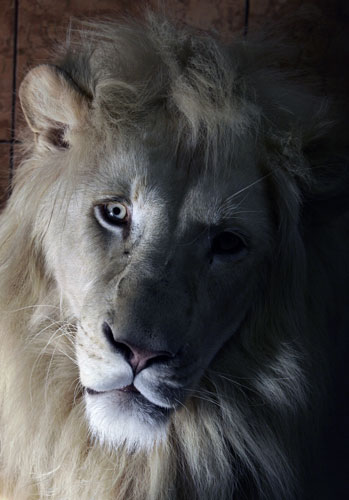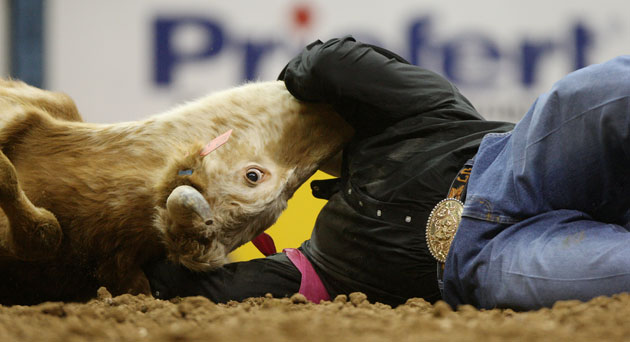Animals are conventional photographic subject and a minor but persistent topic of photojournalism. They are quite prominent in Britain–for example, The Guardian photo page includes “This Week in Wildlife” as a regular feature, and the daily slide show often contains additional images as well. In the U.S. there probably is regional variation reflecting geographic and economic differences, but cute pets and tranquil wildlife are standard fare. Images of pets and zoo animals often contain anthropomorphic appeal, which is exactly why I find this photograph of a white lion in the Belgrade zoo so disturbing.
Penguins splashing in a concrete pool might be happy as clams, but large mammals always appear to be somewhere on a well-worn path to madness. This poor beast could be placed right into one of those paintings of animals playing poker, but for the fact that he looks so sad, at once perplexed and aware of what is happening to him. His intelligence–or emotional intelligence, if you wish–is captured in the brightly lit eye on the left, while the deep shadow on the right side of the photograph suggests that his mind is sliding into darkness. This effect is heightened by how the face appears to twist as it elongates to the nose and mouth. Perhaps but a trick of light, it also is another example of how the photo turns the anthropomorphic impulse against itself. We want to see animals as being like us–curiously, we do this as we make them captive–yet now we are confronted with the thought that they may be sentient and complex and emotional enough to suffer from being confined for our viewing pleasure.
I could quit there, but this was a rich week for animal photography. The next shot provides another angle on looking at animals looking at us.
This black rhinoceros is kept in the Frankfurt zoo. Again, the photo features the animal’s eye, now one that seems to reflect a duller intelligence, one trapped in a perpetual state of trying to comprehend what he sees. What strikes me is that he seems confined and burdened not by the zoo but by his own body. That eye looks out from amidst a huge head weighted with a great mass of horn, part of a massive carcass encased in thick skin, so thick it can become encrusted with mud or mold. That’s a lot to manage, and he seems consumed by the task, so much so that looking at us is almost too much to handle, one more burden for him to carry along with the rest of his bulk.
It could be worse, however.
This rodeo steer is the animal eye taken down to its elemental condition of dumb, uncomprehending fear. He did not evolve for steer wrestling, and he looks out in terror as he lies there on his back, throat exposed. The image still has a strange anthropomorphic element to it, however, because of the way the two bodies converge. We see only the head of the steer while the wrangler’s body is rendered headless by the angle of the camera. The result is a minotaur. In the Greek myth, he had a man’s body with the head of a bull and lived within a maze. He was fearsome but trapped, confined to the maze like an animal in a zoo. The rodeo minotaur also is a figure of captivity. Steer and cowboy alike are trapped in their roles and in their bodies. Thrown together in order to survive, they may have more in common, and more need of one another, than we like to admit.
Photographs by Srdjan Ilic/AP Guardian, Frank May/EPA, and Isaac Brekken/AP Guardian. For an earlier post that ends on the animal eye, go here. If you appreciated the reference to the Greek myth, you might enjoy The Minotaur Takes a Cigarette Break.



[…] this week Hariman commented on how the camera aids our fundamental desire to anthropomorphize animals, to see them “as being […]
A nice companion to your reflections here is John Berger’s marvelous essay, “Why Look at Animals.” He writes specifically about the experience of viewing animals in zoos.
The expression on the animal’s face says it all, but the size of the cages in which these animals live is shocking…not lager than 200 sq.feet
The image of the lion reminded me of a few photos I took back in 2000 in the same zoo:
http://www.flickr.com/photos/djordje/3122825943
http://www.flickr.com/photos/djordje/3122856867
animals see in black and white.
I loved the pictures, but you were WAY off about the Black Rhinoceros. It just struck me hard when you referred to them as having “duller intelligence”. ALL animals, in my perspective, are intelligent in their own gifts. They ALL have a purpose in living in their natural habitat. Anna Merz, a woman who raised a Black Rhinoceros in Africa, concluded that rhinos ARE intelligent; they have learned to open doors, play fetch, know their names, and remember the scent of their caretakers. It just upsets me when people view the rhinoceros as dumb and unimportant – because they’re NOT! Rhinos, as well as that White Lion, suffer GREATY in captivity, too. They bang their heads on doors, wanting desperately to get out. They pace in circles for hours. There are even blood marks on their face sometimes from trying to escape their home in the zoo. Zoos hardly EVER put nice mudholes in the rhino’s enclosures; rhinos NEED to roll in mud to keep insects from biting their tough but sensitive skin. Thus, rhinos at zoos are often seen with many leisures on their beautiful skin.
Rhinos have poor eyesight, but excellent sense of smell and hearing. Like horses, they get frightened easily and have that “flee or attack” instinct. But when raised by a kind person in their natural habitat (and in zoos), they become gentle and trusting animals. Rhinos are misunderstood, amazing animals, and need respect from people.
They are one of the most endangered animals in the world, and 280 have been poached cruelly for their horns already this year. We really need to have a special place in our hearts for this part of God’s creation. Please respect the rhinos! 🙂
God Bless You,
Cathie
I loved the pictures, but you were WAY off about the Black Rhinoceros. It just struck me hard when you referred to them as having “duller intelligence”. ALL animals, in my perspective, are intelligent in their own gifts. They ALL have a purpose in living in their natural habitat. Anna Merz, a woman who raised a Black Rhinoceros in Africa, concluded that rhinos ARE intelligent; they have learned to open doors, play fetch, know their names, and remember the scent of their caretakers. It just upsets me when people view the rhinoceros as dumb and unimportant – because they’re NOT! Rhinos, as well as that White Lion, suffer GREATY in captivity, too. They bang their heads on doors, wanting desperately to get out. They pace in circles for hours. There are even blood marks on their face sometimes from trying to escape their home in the zoo. Zoos hardly EVER put nice mudholes in the rhino’s enclosures; rhinos NEED to roll in mud to keep insects from biting their tough but sensitive skin. Thus, rhinos at zoos are often seen with many leisures on their beautiful skin.
The rhino’s eye in the picture depicts it’s loss of spirit and freedom in it’s spacious, African home – which was taken from them.
Rhinos are most definately not confined by their bodies; that’s how they are made. They are confined and burdened in confinement. Please understand that. Thank you.
Cathie: Thanks for speaking up. I think zoos are shameful, at least in respect to many of the animals there and certainly the large mammals.
When I look into this rhino’s eye, I don’t see a lesser intelligence, but what I do see if fear. Living in zoos, even one of the “better” ones is just a life sentence in prison. I once went to a circus to take undercover photographs of elephants chained up outside a tent. I looked into both their eyes, and they held no hope, no happiness, no life. They looked like a person who had grown up in slavery and knew they would spend the rest of their days until death in slavery. It was one of the most heart wrenching moments in my life. I quietly told them how sorry I was that they were suffering so, and that these photos of their faces and chained feet may bring some hope to other animals in captivity. I don’t understand how anyone could get pleasure out of watching these tortured, enslaved animals performing. 🙁